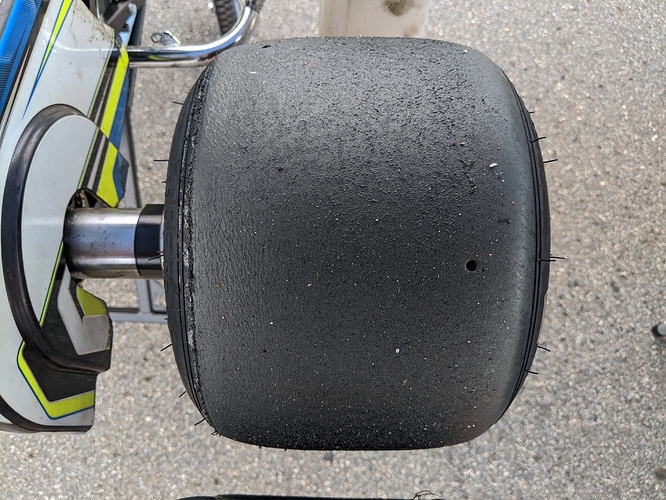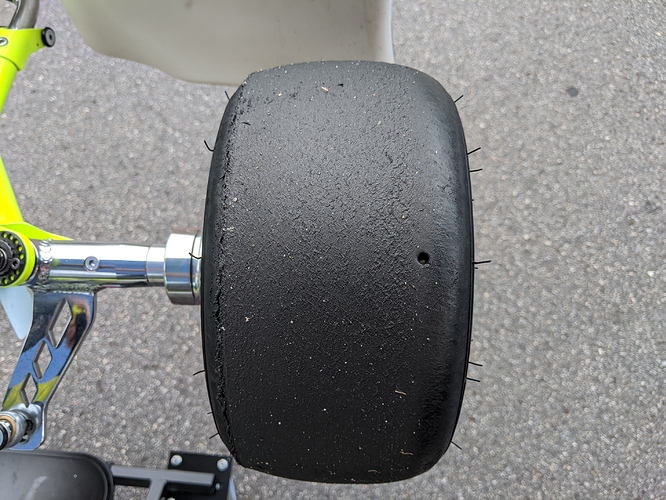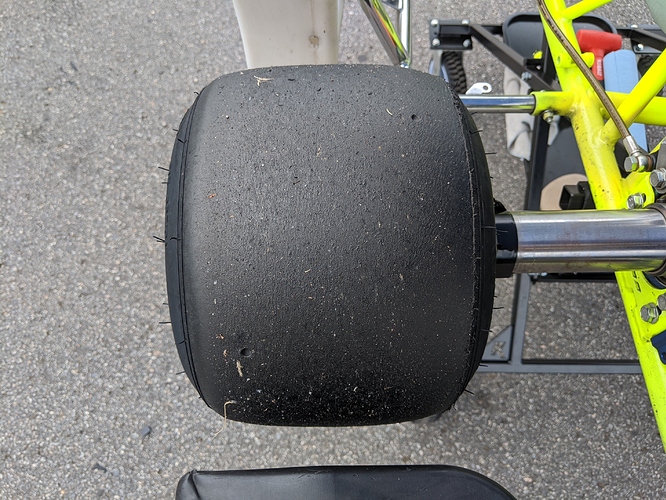We had a similar wear pattern on the fronts of our Intrepid. We corrected it by moving the seat forward. It worked well.
When I raced, karts were not nearly as adjustable as they are today, still there was some adjustability. My thoughts; push = narrow the front, loose = widen the front. Toe = 1/16 in, maybe a little less. Have you ever scaled the kart? You might try moving the seat forward, a small amount goes a long way. lol. There is no “ideal” weight balance for all situations, not karts not drivers not tracks.
If the data does not support the theory, get a new theory! (Al Nunley)
I’ll throw some picture up for diagnosis. GoPro Motorplex KA100 Senior MG Reds for reference. Track was pretty green from some recent rain and rental karts going out every other session. Was really struggling for rear grip all day and I think it shows in the tires. I’ve been out of karting for quite some time and really only turned around 100 laps in total at GPM. I haven’t done much chassis tuning just air pressures and sticking with a baseline setup as I gain seat time. I’m sure some over driving isn’t helping, but try as I might I’m stuck around high 52s and not making much progress. Feel like lack of rear grip is holding me back. Air pressure were all over the place while testing, but these are from my last session running around 14 psi hot all around. Cold was 10 lr, 10.5 lf, 10.5 rr, 11 lf. Thanks for the input!
I ran 12 psi @ gopro, but the MG Reds are unique in that they seemed to work in 2 zones instead of one optimum - at 9-10 ish and 12-13 ish. May depend on setup. The graining on those tires looks pretty reasonable to me, except for the LF, which is perhaps a touch overloaded. I’m used to old school chassis, changing track widths front and rear, but the new chassis seem to adjust caster camber splits and leave tires close to where they started. My guess is the speed will come with seat time and line adjustment, but I never liked the feel of my Praga, which seemed to lack rear grip as well. Good luck!
Ted,
Thanks for the input. Were you around 12 psi hot or cold? I think as my driving settles down the “lack” of rear grip may go down, but for the time being I’ll see what I can do to gain rear grip.
12 psi cold. Rose to 13.5, 14
Widen the front, narrow the rear, change the front/rear weight percentages (move the seat) in that order. It really is just that simple. Get the balance right, then work on the grip, if needed.
Set the tire pressures in the pits, we all know it’s going to go up when they get hot, it’s a given, work with it. Anticipate it. On a hot day, hot track, it’ll probably go up more versus a cold day and a cold track, anticipate it!! I mean really, what else can you do??
Thanks! Might just be the high temps and humidity here currently in the Carolinas, but I’m seeing well over a 1.5 - 2 psi increase at operating temperatures. Probably doesn’t matter too much as long as my hot pressures and handling are were I want them.
Air density, humidity comes in a distant 3rd in importance. Temperature and barometric pressure =Air density. Air density gauge; I consider it the most valuable tool for tuning.
Totally normal to see 2 psi + on a hot day. Your pressures are in the correct range for that tire.
I concur, 2PSI is more-or-less my target increase over the course of a run. If I find one tire or more going above that I might lower the hot pressure to match a 2psi increase.
“Might tweak it” means what, tweak what, the tire, or the kart?
Good question… I edited my post
If I saw a tire getting hotter than expected, I would attribute that to a handling problem and work on that, not play with the pressures. I assume that tire temps above normal are a sign of a handling problem, am I wrong? If the ambient conditions caused an increase in pressure of 2 pounds, anything above that is the reason we take tire temperatures.
I just thought of something; if we set the tire pressure to 12 psi, in the pits, how do we determine how much of an increase there is after running? All the tires are going to be a higher pressure after running, presumably, so how do we determine how much that increase is due to just the fact that the tires have been on the track.
Hypothetically; we go out with the RR at 12 psi. The ambient temperature is 70°. Hypothetically, when we go out, the tire is at 70°. When we come in, the tire is now reading (just for example) 100°. We measure the pressure, and it says 14 psi. A 2 psi increase. If, when we come in, if the temperature of the tire is 120°, or 80°, wouldn’t the increase in pressure be more, or less, depending? I’m pretty sure you can’t automatically assume anything about the pressure. The left front is probably (most likely) not going to be as hot as the RR, what’s the pressure in it? The RR is probably getting worked the hardest, it’s temperature is probably going to rise the most, the tire pressure is going to follow that rising temperature, so who cares. If the kart is handling great, and the RR temperature is 100° (average) who cares what the pressure is, other than just a reference point? If you come in and the temperature is 120°, presumably the tire pressure is up a little higher than normal, you may want to lower the tire pressure, but you may also want to look at the balance of the kart. It’s a quandary, we know the pressure is going to be up, it’s hotter, the question is, why is the tire hotter? The tire temperature is not up because the air pressure is up, the air pressure is up because the tire is hotter.
Presumably, with a database, you could determine why all these things are happening.
“It’s called tuning, and tuning is tough” (Al Nunley)
Tracks generally have a bias in one direction or another so you’ll see different hot pressures from side to side. … Essentially that’s what I’m correcting for over a run, not a handling problem perse.
Tracks are directional, so one corner or side will naturally getting hotter or wear more. I think that’s what James is referring to when he’s adjusting hot pressures like that.
If the right rear is burning off and you’re noticing handling issues from it on a counter-clockwise track, you’ll want to lower that corner to help keep the tire in it’s optimal operating temperature window.
Video seems somewhat relevant to this thread. Those covers seem to be a bit overkill when some quick plastic wrap would do the same job of keep the tires from oxidating. Would have to image the tires would have to sit out uncovered for quite some time before air would age them. Or are they really that volitale?
I have a running excel sheet tracking consumable items such as tires w/ serial numbers, chain, carb, and engine hours so writing on the covers doesn’t appeal to me.
My question is on tire rotation for extending the life? Looks like MG Reds you could flip once or do most people run them until they are done? If you build up camber wear it might really suck for some laps if you flipped them due to the geometry wore into them.
This is exactly what will happen. MGs or some of the more square-profile tires will be dismal if you flip them on the rim after you’ve cambered them in with lots of laps. If you want to flip them to increase longevity, I would be doing it every other session or so, so that it never builds up too much camber.
I’ve seen races won and lost because someone flipped their MG fronts before the final…
Any preference on having them worn in to shape for additional contact patch versus always rotating them to keep them square?
Reminds me of these from some years ago. Guy was producing tires with molded in camber for extra contact patch.



